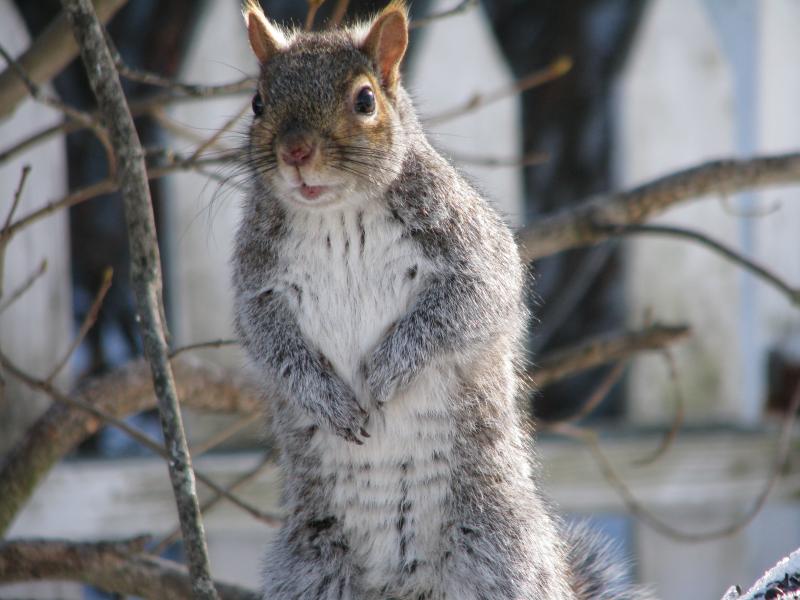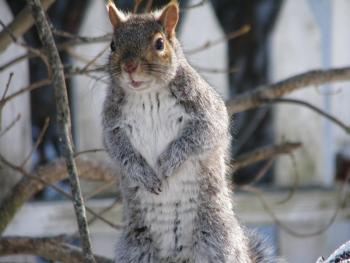Squirrel Booms and Passenger Pigeons in the Year of the Bird
If you’ve been out and about in Maine over the last few months, you’ve probably observed the incredible numbers of gray squirrels and chipmunks seemingly everywhere. Sadly, one of the ways that these high numbers has been most noticeable is the increase in road-killed squirrels. But even just on walks and in our yard we, like many people, have been surprised by the density of squirrels and chipmunks. We can’t remember the last time they were this abundant. And this year’s squirrel population boom is not just in Maine but across all of New England.
This abundance of squirrels and chipmunks is thought to be tied to an exceptional crop of acorns last year that increased overwinter survival and made for healthy females that gave birth to healthy litters of the lively mammals.
Although not in the news like the squirrels, we have also been impressed by incredible numbers of wild turkeys that have been in evidence along roadways over much of the state. Turkeys, too, are fond of acorns in the fall and winter. We’d bet that the increased numbers of turkeys may be connected to the bumper crop of acorns last fall, as well.
Other birds that are known to at least sometimes eat acorns include wood ducks, ruffed grouse, and red-bellied woodpeckers. We’ll all have to keep an eye out to see if we observe any noticeable change in these species’ populations but such a change may not be detectable until the results are in from survey efforts like the upcoming Christmas Bird Count, the summer Breeding Bird Survey, and new Maine Breeding Bird Atlas.
There can be interesting effects of the high squirrel and chipmunk populations that carry over into the next year. Squirrels and chipmunks can be ready predators of the eggs and nestlings of many birds, so high populations could decrease nesting success of some songbirds when the squirrel/chipmunk population boom is at its height. Of course, the flip side of the ecological equation means that squirrels and chipmunks are readily eaten by hawks and owls. Perhaps we will see a bump in numbers of red-tailed hawks and great horned owls next year?
With all the talk of acorn abundance, it’s important to remember that we lost one of the bird species that would have certainly taken advantage of the bumper acorn crop here in New England. Passenger pigeons were known to be fond of acorns, and they were famous for being rather nomadic as they searched out the areas with the largest food sources each year. The birds were so successful in this strategy that their total population in some years was estimated in the billions. Early ornithologists wrote of passenger pigeon flocks passing in migration that blocked out the sun for days! Nesting colonies sometimes stretched over hundreds of miles.
Hundreds of years ago, a bumper crop of acorns in Maine and the rest of New England would have likely meant that we would have seen massive numbers of passenger pigeons here along with the squirrels and turkeys.
But back in those days, our nation did not have conservation laws in place that would have prevented the extinction of the passenger pigeon. In fact, the passing of the last passenger pigeon on Earth in a Cincinnati Zoo in 1914 was part of what inspired the signing of the historic bird protection treaty between the U.S. and Canada called the Migratory Bird Convention. That treaty’s provisions were enacted through the Migratory Bird Treaty Act here in the U.S. in 1918. While too late to save the passenger pigeon, the law has prevented the loss and decline of so many of our bird species including acorn-loving birds like the wood duck—a species that was thought to be on the verge of extinction at the time the bill was signed.
This year we celebrate the 100 year anniversary of that most crucial and historic bird conservation legislation this year, the Year of the Bird!
Jeffrey V. Wells, Ph.D., is a Fellow of the Cornell Lab of Ornithology. Dr. Wells is one of the nation's leading bird experts and conservation biologists and author of “Birder’s Conservation Handbook”. His grandfather, the late John Chase, was a columnist for the Boothbay Register for many years. Allison Childs Wells, formerly of the Cornell Lab of Ornithology, is a senior director at the Natural Resources Council of Maine, a nonprofit membership organization working statewide to protect the nature of Maine. Both are widely published natural history writers and are the authors of the book, “Maine’s Favorite Birds” and the newly published “Birds of Aruba, Bonaire, and Curaçao” from Cornell Press.
Event Date
Address
United States

























